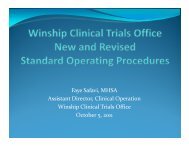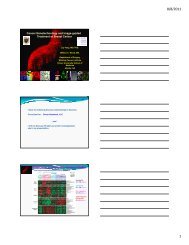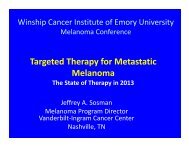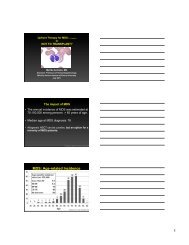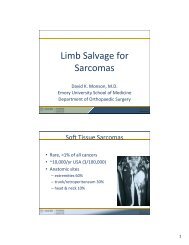Bassel F. El-Rayes, MD - Winship Cancer Institute of Emory University
Bassel F. El-Rayes, MD - Winship Cancer Institute of Emory University
Bassel F. El-Rayes, MD - Winship Cancer Institute of Emory University
You also want an ePaper? Increase the reach of your titles
YUMPU automatically turns print PDFs into web optimized ePapers that Google loves.
Systemic Treatment <strong>of</strong>Pancreatic Neuroendocrine<strong>Bassel</strong> F. <strong>El</strong>-<strong>Rayes</strong>Director GI Oncology Program<strong>Winship</strong> <strong>Cancer</strong> <strong>Institute</strong><strong>Emory</strong> <strong>University</strong>
Background• Rare tumor– Incidence <strong>of</strong> less than 1 per 100,000individuals– Maybe increasing• Pancreatic NET account for 7% <strong>of</strong> allNET• Pancreatic NET account for 1-2% <strong>of</strong> allpancreatic tumors• Median survival:– Early stage: more 10 years
• Familial Syndromes:– MEN 1• menin gene• Pituitary, pancreas, parathyroid• Account for 10%– MEN 2• RET gene• Medullary thyriod, pheochromcytoma,hyperparathyriodism– Tuberous sclerosis, von Hippel-Lindau,neur<strong>of</strong>ibromatosis
Classification <strong>of</strong>Pancreatic NET
Grading SystemGrade MitoticCountKi67 Index DifferentiationLow GradeIntermediat20 >20 differentiatedPoorlydifferentiated
When do we considersystemic therapy in
Systemic therapy is only foradvanced stage disease.
Clinical CourseSymptoms related to masseffectSymptoms related to secretionRate <strong>of</strong> Progression
Treatment Options for• If disease is resectable (primary plusmetastatic site)- resection is thepreferred treatment.• If the disease is not resectable, notprogressing and asymptomatic thenobservation is usually the preferred
Treatment for Advanced Stage• If symptomatic (not due to secretion)or evidence <strong>of</strong> disease progressionthen options include:– Surgical Debulking– Interventional Oncology based therapies• Catheter directed therapy: Y90, TACE• Ablation– Systemic therapy
Treatment Options for• Gastrinoma: Proton Pump Inhibitors+Octreotide• Insulinoma: Manage hypoglycemia,Diazoxide +/- Octreotide• Glucagonoma: Octreotide• VIPoma: Manage electrolytes+Octreotide
Systemic Treatment <strong>of</strong>Advanced Pancreatic NET
Somatostatin Receptors• Majority <strong>of</strong> pancreatic NET will expresssomatostatin receptors.• Each <strong>of</strong> the 5 SST receptor subtypes(SST1-5) has 7 transmembranespanningdomains• These receptors are coupled to Gproteins, which dissociate in responseto ligand binding and act on any <strong>of</strong>several downstream effector proteinsLamberts et al. N Engl J Med. 1996;334:246-254.
Effect <strong>of</strong> SST Analogs on CellSOM230SOM230sst 2sst 1 sst 2sst 3G proteinSHP1↑p53BaxG proteinSHP1NF-KBJNKPI3KGSK3βp53↑Zac1PDK1AktmTORRAD001p70S6KSOM230G proteinPTPŋSHP2SrcMAPKp27SOM230G proteinSHP1↓ PKG↓ cGMPG proteinSOM230sst 5↑ Apoptosis↓ Cell growthFlorio et al. Front Biosci. 2008;13:822-840.Grozinsky-Glasberg et al. Neuroendocrinology. 2008;87:168-181Theodoropoulou et al. <strong>Cancer</strong> Res 2006;66:1576-1582This diagram is a generalized representation <strong>of</strong> the intracellular signaling pathways that may be used by sst receptors to mediate the direct effects <strong>of</strong> sst on cellgrowth and proliferation, depending on the makeup <strong>of</strong> the cell.Not all cells contain all pathways or all sst receptors.Not all sst receptors use all pathways.New pathways continue to be identified.Pathways used by sst receptors <strong>of</strong>ten overlap.All sst receptors activate phosphotyrosine phosphatases (SHP-1, SHP-2, PTP-η), and modulate mitogen-activated protein kinase (MAPK).sst receptor stimulation can block the effects <strong>of</strong> growth factor receptor stimulation.sst receptor stimulation can result in increased production <strong>of</strong> the cell cycle inhibitor p27.Pathways used by sst receptors overlap with pathways used by chemotherapeutic agents.For example, in vitro findings suggest that both sst receptors and the mTOR inhibitor everolimus act through a similar pathway and inhibit Akt-mTORp70S6kinase.ReferencesFlorio et al. Front Biosci. 2008;13:822-840.Grozinsky-Glasberg et al. Neuroendocrinology. 2008;87:168-181.Jacobs and Schulz. Mol Cell Endocrinol. 2008;286:58-62.Lahlou et al. J Biol Chem. 2003;278:39356-39371.Lopez et al. FASEB J. 2001;15:2300-2302.Patel. Front Neuroendocrinol. 1999;20:157-198.Weckbecker et al. Nat Rev Drug Discov. 2003;2:999-1017.
Octreotide• Octreotide binds to SST2. Newerpasireotide binds to SST1, SST2, SST3,SST5.• Octreotide 150-250 mcg subcutaneouslythree times a day• Octreotide LAR 20-30 mg intramuscularlyevery 4 weeks• Short acting octreotide can be added tooctreotide LAR for treatment <strong>of</strong>
PROMID TrialRinke A et al. JCO 2009;27:4656-4663Study flow chart for time to progression or tumor-related death. ITT, intent to treat.
PROMID ResultsRinke A et al. JCO 2009;27:4656-4663(A) Conservative intent-to-treat analysis <strong>of</strong> time to progression or tumor-related death. (B) Intent-to-treat analysis <strong>of</strong> overall survival.HR, hazard ratio.
Patient Case62 year old male patientpresented with over 1year history <strong>of</strong> diarrhea,fatigue and occasionalflushing.Initial work up revealedelevated LFT.CT scan showed multipleliver lesions andpancreatic mass.Biopsy welldifferentiated NET
Patient Case 1• What is the next step?– Observation– Octreotide– Octreotide+ Liver directed therapy– Octreotide + everolimus– Everolimus– Sunitinib
Patient Case 1• Started on octreotide LAR 20 mg didwell for 15 months then started tohave worsening diarrhea.• Octreotide increased to 30 mg then 40mg with progressively worsening <strong>of</strong>diarrhea.• Repeat CT scan reveals stable disease.• Next step?
Antiangiogenic therapy
Sunitinib Malate for theTreatment <strong>of</strong> PancreaticPancreaticNETAdvanced86 patients85 patientsSunitinib 37.5 mgper dayPlaceboRaymond et.al. N Engl J Med 2011
Raymond et.al. N Engl J Med 2011
Raymond et.al. N Engl J Med 2011
Raymond et.al. N Engl J Med 2011
Raymond et.al. N Engl J Med 2011
mTOR Inhibitors
Everolimus for the Treatment<strong>of</strong> Pancreatic NeuroendocrinePancreaticNETAdvanced207 patients208 patientsEverolimus 10 mgper dayPlaceboYao et.al. N Engl J Med 2011
Yao et.al. N Engl J Med 2011
Yao et.al. N Engl J Med 2011
Yao et.al. N Engl J Med 2011
Yao et.al. N Engl J Med 2011
Agents in EarlierDevelopment
Pazopanib• Pazopanib was evaluated in a multiinstitutionphase II study– 51 patients , 29 <strong>of</strong> which had PNET• Pazopanib 800 mg daily + toocterotide LAR.• The response rate in 19 patients withPNETswas reported to be 17%.Phan et al., 2010
Sorafenib• Evaluated in a phase II study– 43 patients with PNET• Patients received sorafenib 400 mgtwice daily.• In a preliminary analysis, 10% <strong>of</strong>patients with PNET were observed tohave a partial responseHobday et al., 2007
Bevacizumab• Phase II trial <strong>of</strong> everolimus andbevacizumab– Overall response rate <strong>of</strong> 26%• CALGB 80701: randomizing patientswith advanced PNET to eithereverolimus or everolimus +bevacizumab.Yao et al., 2010b
Systemic and LocoregionalTherapyPasireotideEverolimusMaintenance Pasireotide/EverolimusSIRTSIRTSerumCorrelatives
Cytotoxic Therapy
StreptozocinRegimen Patients Response PFS Type <strong>of</strong>studyReferenceStreptozocinDoxorubicinStreptozocFluorouracinilFluorouracil StreptozocinDoxorubicin84 39 18 R Kouvaraki200433 45 14 P Moertel199236 69 18 P Moertel19921. Moertel et al., 198 2 2.Kulke et al., 2010a 3.Moertelet al., 1992 4.Moertel et al., 1992 5.Kouvaraki et al.,2004
TemozolomideRegimen Patients Response PFS Type <strong>of</strong>StudyTemozolomideTemozolomideTemozolomideThalidomideTemozolomideBevacizumaTemozolomibdeEverolimusTemozolomideCapecitabineReference12 8 NA R Ekebald200753 34 13.6 R Kulke200911 45 NA P Kulke200617 24 8.6 P Kulke200624 35 NA P Kulke201030 70 18 R Strosberg2010
MGMT Expression in Carcinoid andPancreatic NETKulke M H et al. Clin <strong>Cancer</strong> Res 2009;15:338-345Representative MGMT staining in carcinoid and pancreatic neuroendocrine tumors.
PFS and OS for NET patients treated withtemozolomide-based therapyKulke M H et al. Clin <strong>Cancer</strong> Res 2009;15:338-345PFS and OS for carcinoid and pancreatic neuroendocrine tumor patients treated with temozolomide-based therapy. A, median PFSwas 13.6 mo for pancreatic neuroendocrine tumor patients and 9.6 mo for carcinoid tumor patients (P = 0.12). B, median OS was35.3 mo for pancreatic neuroendocrine tumor patients and 19.4 mo for carcinoid tumor patients (P = 0.07).
PFS and OS based on MGMT-Status in NETTreated with temozolomide-based therapyKulke M H et al. Clin <strong>Cancer</strong> Res 2009;15:338-345PFS and OS in patients with MGMT-intact or MGMT-deficient neuroendocrine tumors treated with temozolomide-based therapy. A,median PFS was 19.2 mo for MGMT-deficient neuroendocrine tumors and 9.3 mo for MGMT-intact tumors (P = 0.11). B, median OSfor patients with MGMT-deficient tumors was not reached; median OS for patients with MGMT-intact tumors was 19.1 mo (P = 0.14).
Case 1- Continued• After an additional 7 months <strong>of</strong>therapy he developed newsupraclavicular and mediastinal nodes.Biopsy confirmed NET. CT liver stable.• Options at this time– Continue octreotide– Start everolimus– Start sutent– Start chemotherapy (temozolomide)– Consider liver directed therapy
Case 2• 42 year old male patient presents withnon specific abdominal pain anddecreased appetite.• On MRI found to have alarge pancreatic mass• Biopsy: NET• Surgical evaluation:borderline resectable
Case 2• Options– Observation– Octreotide– Sunitinib– Everolimus– Cytotoxic chemotherapy
Conclusion• Options for management <strong>of</strong> advancedpancreatic NET include– Surgery– Liver directed therapy– Systemic therapy• Systemic therapeutic options forpancreatic NET include– Octreotide– Everolimus– Sunitinib– Chemotherapy: temozolomide or streptozocin






